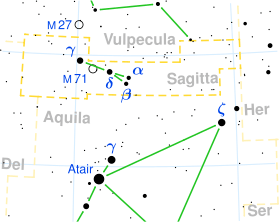Alpha Sagittae
 | |
| Observation data Epoch J2000.0 Equinox J2000.0 (ICRS) | |
|---|---|
| Constellation | Sagitta |
| Right ascension | 19h 40m 05.8s[1] |
| Declination | +18° 00′ 50″[1] |
| Apparent magnitude (V) | +4.39[2] |
| Characteristics | |
| Spectral type | G1 II[2] |
| Astrometry | |
| Radial velocity (Rv) | 1.72 ± 0.16[3] km/s |
| Proper motion (μ) | RA: 15.09 ± 0.16[1] mas/yr Dec.: -19.65 ± 0.15[1] mas/yr |
| Parallax (π) | 7.67 ± 0.24[1] mas |
| Distance | 430 ± 10 ly (130 ± 4 pc) |
| Absolute magnitude (MV) | −0.96[4] |
| Details | |
| Mass | 4.11[5] M☉ |
| Luminosity | 340[2] L☉ |
| Surface gravity (log g) | 3.11[2] cgs |
| Temperature | 5,333[2] K |
| Metallicity [Fe/H] | −0.15[2] dex |
| Age | 151[5] Myr |
| Other designations | |
| Database references | |
| SIMBAD | data |
Alpha Sagittae (α Sagittae, abbreviated Alpha Sge, α Sge), also named Sham,[6] is a star in the constellation of Sagitta. Based upon parallax measurements taken during the Hipparcos mission, it is approximately 430 light-years from the Sun.
Nomenclature
α Sagittae (Latinised to Alpha Sagittae) is the star's Bayer designation.
It bore the traditional name Sham (or Alsahm), which derives from the Arabic word سهم sahm, meaning "arrow", the name formerly having been applied to the whole constellation. In 2016, the International Astronomical Union organized a Working Group on Star Names (WGSN)[7] to catalogue and standardize proper names for stars. The WGSN approved the name Sham for this star on 12 September 2016 and it is now so included in the List of IAU-approved Star Names.[6]
In Chinese, 左旗 (Zuǒ Qí), meaning Left Flag, refers to an asterism consisting of Alpha Sagittae, Beta Sagittae, Delta Sagittae, Zeta Sagittae, Gamma Sagittae, 13 Sagittae, 11 Sagittae, 14 Sagittae and Rho Aquilae. Consequently, Alpha Sagittae itself is known as 左旗一 (Zuǒ Qí yī, English: the First Star of Left Flag).[8]
Properties
Alpha Sagittae is a yellow bright giant star of apparent magnitude +4.38 and spectral class G1 II. It has a luminosity of 340 L☉ with a surface temperature of 5,333 K.[2] The star's radius is roughly 20 R☉ while its mass is 4 M☉.
References
- 1 2 3 4 5 van Leeuwen, F. (2007). "Validation of the New Hipparcos Reduction". Astronomy and Astrophysics. 474 (2): 653–64. arXiv:0708.1752. Bibcode:2007A&A...474..653V. doi:10.1051/0004-6361:20078357.
- 1 2 3 4 5 6 7 Mallik, Sushma V. (December 1999), "Lithium abundance and mass", Astronomy and Astrophysics, 352: 495–507, Bibcode:1999A&A...352..495M
- ↑ Soubiran, C.; Bienaymé, O.; Mishenina, T. V.; Kovtyukh, V. V. (2008). "Vertical distribution of Galactic disk stars. IV. AMR and AVR from clump giants". Astronomy and Astrophysics. 480: 91. arXiv:0712.1370. Bibcode:2008A&A...480...91S. doi:10.1051/0004-6361:20078788.
- ↑ Kovtyukh, V. V.; Gorlova, N. I.; Belik, S. I. (2012). "Accurate luminosities from the oxygen λ7771-4 Å triplet and the fundamental parameters of F-G supergiants". Monthly Notices of the Royal Astronomical Society. 423 (4): 3268. arXiv:1204.4115. Bibcode:2012MNRAS.423.3268K. doi:10.1111/j.1365-2966.2012.21117.x.
- 1 2 Takeda, Yoichi; Sato, Bun'ei; Murata, Daisuke (2008). "Stellar Parameters and Elemental Abundances of Late-G Giants". Publications of the Astronomical Society of Japan. 60 (4): 781. arXiv:0805.2434. Bibcode:2008PASJ...60..781T. doi:10.1093/pasj/60.4.781.
- 1 2 "Naming Stars". IAU.org. Retrieved 16 December 2017.
- ↑ IAU Working Group on Star Names (WGSN), International Astronomical Union, retrieved 22 May 2016.
- ↑ (in Chinese) AEEA (Activities of Exhibition and Education in Astronomy) 天文教育資訊網 2006 年 7 月 3 日